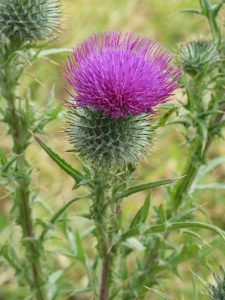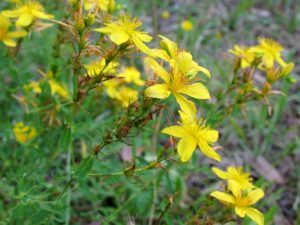
Black or spear thistle
When it comes to weeds, bare ground is your enemy, and there is plenty of it after this long, dry period. With even a small amount of rain, weeds tend to germinate and fill gaps in ground cover before more desirable species get a chance. How has this season affected weed growth, how are landholders responding and what do we need to look out for over the next couple of months?
Low rainfall since last July, combined with uneven distribution (only 10mm in January) and high temperatures over summer have resulted in significant reduction in groundcover and pasture production. Andrew Taylor from South East Local Land Services said “Many farmers have responded by destocking or providing supplementary feed with hay, silage and grain. Luckily (for beef farmers at least) cattle have generally been in good condition, prices have been good and hay prices have been reasonable”.
Unfortunately, grazing pressure on native grasses has also been high this season, particularly from native animals like kangaroos. So whilst landholders may have started to de-stock to deal with the poor conditions, the reduction in groundcover has continued.
The upside is that many weeds are struggling in the heat so even though warm weather usually means an increase in the growth rate and spread of weeds, the lack of moisture has slowed many of them down, giving landholders a chance to focus on other activities on their properties.
A plus for native grassland or grassy woodland areas is that exotic, moisture-loving grasses and clover haven’t thrived this summer, reducing competition from them in these areas and reducing the weed control load for landholders maintaining these areas for conservation.

St John’s wort
However, it’s worth noting that hardier weeds like African lovegrass, St John’s Wort and Serrated tussock that originate from dry areas have continued to grow throughout the season so continuing to control these is important. For information on these visit the CMN website’s weeds page.
People who rely on spot spraying weeds to keep them in check through spring and summer have found this difficult recently. Weeds need to be actively growing to translocate herbicides effectively and the dry conditions have left most weeds too stressed. Other options like hand pulling or chipping out may need to be used.
What to look out for over the next couple of months? Some weeds, like fleabane, thistles and mullein, could respond to the recent rain by kicking into flower and setting seed. Check for these, particularly in damper areas of your property, like around dams, in seepage areas and on shady, south-facing slopes. Rain now and into autumn can also germinate the seeds of cooler season weeds such as fireweed.
If you do have bare ground, now is a good time to keep an eye on these areas and, if you can recognise the weeds whilst they’re small, control them before they become established.
As always, if you need a hand with identification or control advice, contact the Vegetation Management Team at Bega Valley Shire Council on 6499 2222 or email jdixon-keay@begavalleyshire.nsw.gov.au




What is the role of weeds in soil stabilization and erosion control? Surely we need to vegetate bare ground as a priority to protect topsoil?
Thanks for your message Michele. You’re right that maintaining healthy groundcover is a priority. It is hard to build topsoil once we lose it. However, we control weeds because they spread fast and outcompete native vegetation if it is not in good condition. This then affects the quality of habitat for other native plants and animals, reducing biodiversity. If there is already bare ground, one approach is to cut bunches of native grass seed heads and use these in the gaps as a light mulch. Hopefully then you will get some native regeneration in those areas. Another short term measure is to leave the weeds in place to hold the soil but be vigilant about removing any flowering parts so they can’t set seed and spread into other areas. With this approach you would need a follow up native plant revegetation plan.